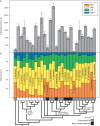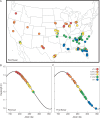Importance of whole-plant biomass allocation and reproductive timing to habitat differentiation across the North American sunflowers
- PMID: 28203721
- PMCID: PMC5604586
- DOI: 10.1093/aob/mcx002
Importance of whole-plant biomass allocation and reproductive timing to habitat differentiation across the North American sunflowers
Abstract
Background and aims: Trait-based plant ecology attempts to use small numbers of functional traits to predict plant ecological strategies. However, a major gap exists between our understanding of organ-level ecophysiological traits and our understanding of whole-plant fitness and environmental adaptation. In this gap lie whole-plant organizational traits, including those that describe how plant biomass is allocated among organs and the timing of plant reproduction. This study explores the role of whole-plant organizational traits in adaptation to diverse environments in the context of life history, growth form and leaf economic strategy in a well-studied herbaceous system.
Methods: A phylogenetic comparative approach was used in conjunction with common garden phenotyping to assess the evolution of biomass allocation and reproductive timing across 83 populations of 27 species of the diverse genus Helianthus (the sunflowers).
Key results: Broad diversity exists among species in both relative biomass allocation and reproductive timing. Early reproduction is strongly associated with resource-acquisitive leaf economic strategy, while biomass allocation is less integrated with either reproductive timing or leaf economics. Both biomass allocation and reproductive timing are strongly related to source site environmental characteristics, including length of the growing season, temperature, precipitation and soil fertility.
Conclusions: Herbaceous taxa can adapt to diverse environments in many ways, including modulation of phenology, plant architecture and organ-level ecophysiology. Although leaf economic strategy captures one key aspect of plant physiology, on their own leaf traits are not particularly predictive of ecological strategies in Helianthus outside of the context of growth form, life history and whole-plant organization. These results highlight the importance of including data on whole-plant organization alongside organ-level ecophysiological traits when attempting to bridge the gap between functional traits and plant fitness and environmental adaptation.
Keywords: Biomass; Helianthus; bud; climate; daylength; flower; growing season; leaf; life history; root; soil fertility; stem.
© The Author 2017. Published by Oxford University Press on behalf of the Annals of Botany Company. All rights reserved. For Permissions, please email: journals.permissions@oup.com
Figures



Similar articles
-
Evolution of the leaf economics spectrum in herbs: Evidence from environmental divergences in leaf physiology across Helianthus (Asteraceae).Evolution. 2015 Oct;69(10):2705-20. doi: 10.1111/evo.12768. Epub 2015 Sep 29. Evolution. 2015. PMID: 26339995
-
Evidence of correlated evolution and adaptive differentiation of stem and leaf functional traits in the herbaceous genus, Helianthus.Am J Bot. 2016 Dec;103(12):2096-2104. doi: 10.3732/ajb.1600314. Epub 2016 Dec 13. Am J Bot. 2016. PMID: 27965237
-
Ontogeny strongly and differentially alters leaf economic and other key traits in three diverse Helianthus species.J Exp Bot. 2013 Oct;64(13):4089-99. doi: 10.1093/jxb/ert249. Epub 2013 Sep 28. J Exp Bot. 2013. PMID: 24078673
-
The role of fecundity and reproductive effort in defining life-history strategies of North American freshwater mussels.Biol Rev Camb Philos Soc. 2013 Aug;88(3):745-66. doi: 10.1111/brv.12028. Epub 2013 Feb 28. Biol Rev Camb Philos Soc. 2013. PMID: 23445204 Review.
-
How do leaf veins influence the worldwide leaf economic spectrum? Review and synthesis.J Exp Bot. 2013 Oct;64(13):4053-80. doi: 10.1093/jxb/ert316. J Exp Bot. 2013. PMID: 24123455 Review.
Cited by
-
Shade and nutrient-mediated phenotypic plasticity in the miracle plant Synsepalum dulcificum (Schumach. & Thonn.) Daniell.Sci Rep. 2019 Mar 26;9(1):5135. doi: 10.1038/s41598-019-41673-5. Sci Rep. 2019. PMID: 30914788 Free PMC article.
-
Soil moisture incidentally selects for microbes that facilitate locally adaptive plant response.Proc Biol Sci. 2023 Jun 28;290(2001):20230469. doi: 10.1098/rspb.2023.0469. Epub 2023 Jun 28. Proc Biol Sci. 2023. PMID: 37357863 Free PMC article.
-
Leaf economic strategies drive global variation in phosphorus stimulation of terrestrial plant production.Nat Commun. 2025 Jul 1;16(1):5562. doi: 10.1038/s41467-025-60633-4. Nat Commun. 2025. PMID: 40592828 Free PMC article.
-
Optimizing Photoperiod Switch to Maximize Floral Biomass and Cannabinoid Yield in Cannabis sativa L.: A Meta-Analytic Quantile Regression Approach.Front Plant Sci. 2022 Jan 10;12:797425. doi: 10.3389/fpls.2021.797425. eCollection 2021. Front Plant Sci. 2022. PMID: 35082815 Free PMC article.
-
Evolutionary Rescue as a Mechanism Allowing a Clonal Grass to Adapt to Novel Climates.Front Plant Sci. 2021 May 17;12:659479. doi: 10.3389/fpls.2021.659479. eCollection 2021. Front Plant Sci. 2021. PMID: 34079569 Free PMC article.
References
-
- Ackerly DD, Cornwell WK.. 2007. A trait-based approach to community assembly: partitioning of species trait values into within- and among-community components. Ecology Letters 10: 135–145. - PubMed
-
- Bazzaz FA, Chiariello NR, Coley PD, Pitelka LF.. 1987. Allocating resources to reproduction and defense. Bioscience 37: 58–67.
-
- Bloom AJ, Chapin FS III, Mooney HA.. 1985. Resource limitation in plants – an economic analogy. Annual Review of Ecology and Systematics 16: 363–392.
-
- Brouillette LC, Mason CM, Shirk RY, Donovan LA.. 2014. Adaptive differentiation of traits related to resource use in a desert annual along a resource gradient. New Phytologist 201: 1316–1327. - PubMed
MeSH terms
Associated data
LinkOut - more resources
Full Text Sources
Other Literature Sources
Miscellaneous

